At The Seedlings Montessori school, our Montessori curriculum and methodology goes far beyond basic academic subjects. Our programs for children 12 months through 6 years of age are customized to each child’s academic need. Children are encouraged to explore and learn through project-based/hands-on activities. Our curriculum is STEAM infused while keeping core Montessori values. We are confident that we will give your child an excellent foundation for an independent, self-directed time of learning.
PRACTICAL LIFE
Practical Life is a desired and sought-after area in the classroom, which transgresses beautifully throughout all other areas of the environment. Children love to do the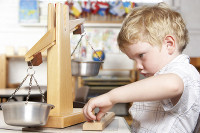 se activities because they are able to individually engage themselves in real-life, daily activities. By focusing on these adult activities, the student acquires personal growth as an individual. Children can grow and relate by doing activities such as spooning and pouring dry goods or liquids, threading beads, sweeping up spills, washing their hands, and learning how to communicate with peace and courtesy in the toddler and primary years.
se activities because they are able to individually engage themselves in real-life, daily activities. By focusing on these adult activities, the student acquires personal growth as an individual. Children can grow and relate by doing activities such as spooning and pouring dry goods or liquids, threading beads, sweeping up spills, washing their hands, and learning how to communicate with peace and courtesy in the toddler and primary years.
In the elementary years, the children will often be found cooking, sewing, gardening, and engaging in activities that extend outside of the classroom and into the community as their practical life work. Concentration in these types of activities allows children to teach themselves how to adapt in society, as well as learn coordination of movement and develop a sense of order. The most important attribute learned through these activities is the knowledge of how to be a purposeful and functional member of society.
SENSORIAL
Sensorial materials are designed to engage the learner. These activities are purposeful and allow the child to verbally define and refine their language with respect to color, texture, size weight, shape and smell.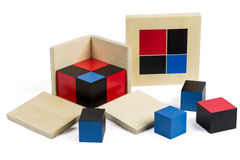
Sensorial activities are designed to reinforce the five senses and to help guide the children in learning to discriminate, classify and compare. Sensorial exercises help prepare for intellectual development in an orderly manner. They teach knowledge and understanding of the world.
The iconic pink tower and red rods fall into the category of sensorial materials. The early use of these materials develop a sense of order in the child which she or he can apply to the world around them. The sensorial materials support the child’s psychological and neurological development. Indirect benefits of sensorial work include, but are not limited to, mathematical preparation, increased attention span, improved hand/eye coordination and the development of logical thinking. The Sensorial materials lay a solid foundation for Mathematics, Geometry, Geography, Botany, Art and Music.
LANGUAGE
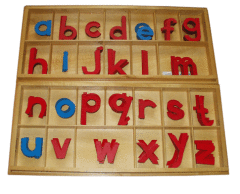 Young children have a phenomenal ability to absorb language. The child learns oral language naturally. They automatically absorb it from their environment. Every effort is made to give each child as much precise vocabulary as possible. The process of absorbing and expressing is encouraged whether individually or in a group. This is a very important part of the Montessori curriculum and meets all the early learning goals. Sandpaper letters are used to introduce the sounds of the alphabet to the child when they are ready.
Young children have a phenomenal ability to absorb language. The child learns oral language naturally. They automatically absorb it from their environment. Every effort is made to give each child as much precise vocabulary as possible. The process of absorbing and expressing is encouraged whether individually or in a group. This is a very important part of the Montessori curriculum and meets all the early learning goals. Sandpaper letters are used to introduce the sounds of the alphabet to the child when they are ready.
In the Montessori class, children utilize all their senses to help them read and write with proper understanding. Discovering Language becomes interesting, fun and a creative process for the child. Each child works at their own pace. Gradually, through daily practice, writing, reading, and communication skills will develop.
MATH
The material for Math introduces the child to associate quantity and its symbols. The quantities are introduced by a series of bead bars, which the child can count. 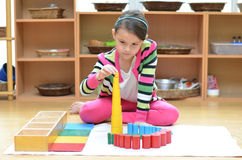 The Math materials are designed to give the child a sound understanding of numbers and their relationship. This work is always introduced in a simple and sensorial way so that the child can see, hold, and feel the number or quantity and gradually be led to an abstract understanding.
The Math materials are designed to give the child a sound understanding of numbers and their relationship. This work is always introduced in a simple and sensorial way so that the child can see, hold, and feel the number or quantity and gradually be led to an abstract understanding.
All of the Math material from the toddler to the elementary classroom is color coded. Using a wide range of beads and symbol cards, the child becomes familiar with the numbers as a decimal system, including concrete experiences with the operations of addition, subtraction, multiplication, and division.
These experiences not only teach the child to calculate, but they provide a deep understanding of how numbers function and the relationship between the quantity and symbol. Abstract work comes naturally to the elementary child because of the solid foundation in Math work from previous years.
CULTURAL STUDIES
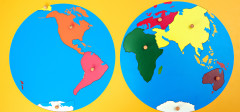 (Physical and Life Sciences, Geography, History)An ecological perspective highlights the interrelationships of the earth, its flora and fauna, and human life. The young child orders simple classifications of non-organic and organic forms and identifies basic parts of plants an animals. The young child discovers the richly varied way in which people meet the same basic needs in relation to differences in topography, climate, and natural resources. This study is expanded at the elementary level to explore the relationships among living and non-living elements, with a focus on connections and functions. The evolution of human societie
s is examined as part of the whole unfolding of life on earth. (The Whole School Montessori Handbook, 1999)
(Physical and Life Sciences, Geography, History)An ecological perspective highlights the interrelationships of the earth, its flora and fauna, and human life. The young child orders simple classifications of non-organic and organic forms and identifies basic parts of plants an animals. The young child discovers the richly varied way in which people meet the same basic needs in relation to differences in topography, climate, and natural resources. This study is expanded at the elementary level to explore the relationships among living and non-living elements, with a focus on connections and functions. The evolution of human societie
s is examined as part of the whole unfolding of life on earth. (The Whole School Montessori Handbook, 1999)























